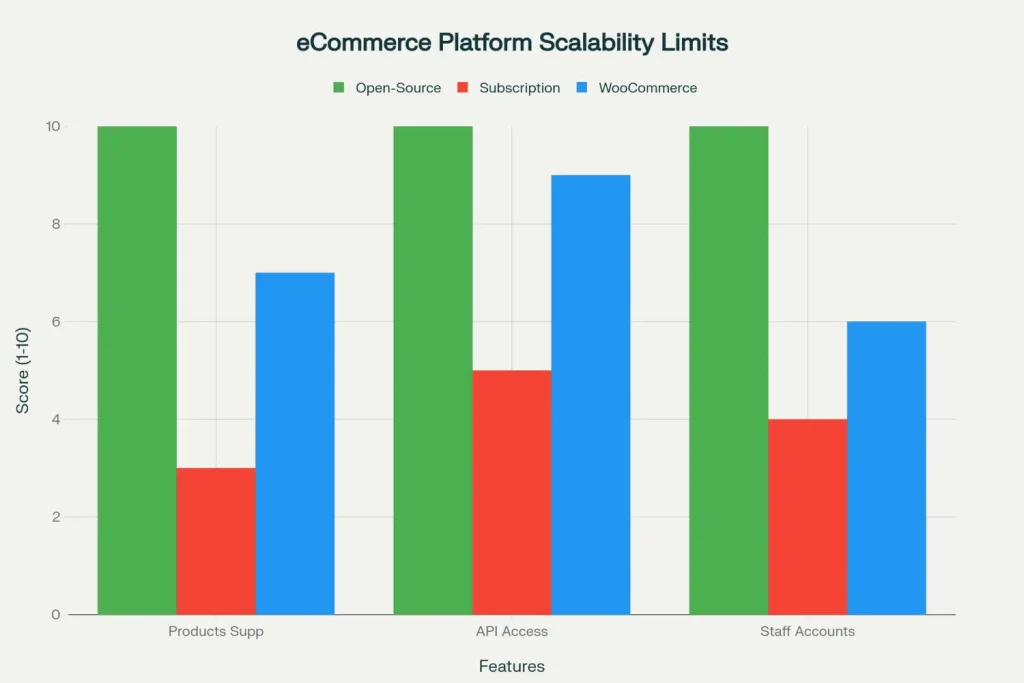- Lifetime Solutions
VPS SSD:
Lifetime Hosting:
- VPS Locations
- Managed Services
- SEO Services
- Support
- WP Plugins
- Concept

To dive into the details of particular open-source ecommerce systems, it is essential to understand what open-source ecommerce is and why the choice of the particular platform is one of the most important decisions that influence the cost of a startup, its scalability, and its future scalability. An open-source ecommerce is defined as free software of websites at which the source code is open or publicly available, and any person can install, edit, and tailor it. Open-source platforms are free to license, unlike proprietary platforms such as Shopify, BigCommerce, which have to be paid monthly fees, but web hosting and technical setup are required.
Here is an example of a real-world analogy: Shopify costs a 29-299/month subscription and transaction fee (2.9% and 0.30 per sale). A small store is required to pay subscription fees amounting to $350-3,600 over 12 months only. The open-source platforms (WooCommerce, Magento, PrestaShop) are free of license; only web hosting (5-50/month) is required, as well as optional extensions/plugins. When a store spends $10/month on hosting and + $200/year on the plugins, it will be paying 320 a year, which is 87% lower than the minimum plan of Shopify. Since bootstrapped entrepreneurs and small businesses have limited resources, this difference in cost is the difference between having an online store and not.
The ecommerce market in the world has grown to 6.3 trillion and is growing fast to reach 8+ trillion by 2030, which is 8-9% per year. The Internet has an estimated 45 percent share of self-hosted ecommerce stores that use open-source platforms. The market share of WooCommerce is 29 percent of all ecommerce platforms (most popular), 10 percent is held by Magento, 2 percent by PrestaShop, 1.5 percent by OpenCart, and others. The disruptive nature of the open-source ecommerce development shows a basic fact: the entrepreneurs are getting to abandon the recurring subscription-based model and get to be the owners of their technology. The adoption of open-source is increasing at 15-20% per year as more people get to know about the cost savings and flexibility benefits.
The choice of an ecommerce platform has a direct influence on three key success factors, which include (1) startup costs, the amount of money that you require initially, (2) long-term ownership, whether you are the owner or rent your store, and (3) scalability, whether the platform can scale as your business grows. The savings of thousands of dollars in the first 3-5 years through selecting open-source ecommerce over subscription services, along with the ability to have full ownership and unlimited customization capabilities.

Most new entrepreneurs fail to choose Shopify or WooCommerce without consideration or knowledge of trade-offs. This option of default option often incurs thousands of dollars of unwarranted subscriptions or binds businesspeople to rigid systems. Nevertheless, studies validate that the selection of ecommerce platforms has a direct effect on several key business indicators that define success and profitability in the long term. Knowledge of these factors will turn novice thoughts of any platform being fine to the platform choice being cost-effective, ownership, and scalability.
Startup Costs and Profitability: Ecommerce profitability depends on gross margin minus operational costs. Every dollar saved in platform fees directly increases profit. A store generating $100,000 annual revenue saves $3,000-5,000 annually by choosing open-source ($320/year) instead of Shopify ($3,500-5,000/year). This $2,680-4,680 annual savings represents a 5-10% profit improvement for typical stores operating on 10-20% margins. Over 5 years, platform choice difference = $13,400-23,400 in cumulative savings—substantial impact for survival in competitive markets.
Ownership and Control: Subscription platforms (Shopify, BigCommerce) own your store. If the platform raises prices, restricts features, or changes policies, you comply or migrate. Open-source platforms give you complete ownership, you control every aspect. This ownership means unlimited customization, no feature restrictions, and freedom from subscription increases. For long-term businesses, ownership provides security and flexibility that subscription dependence cannot match.
Scalability and Flexibility: Subscription platforms impose feature limits (product limits, staff account limits, API rate limits). As your business grows, you eventually hit platform ceilings requiring migration. Open-source platforms scale infinitely, limited only by server resources you control. A successful business grows from 1,000 to 10,000 products without platform constraints. This scalability prevents expensive migrations later.
Integration and Customization: The subscription platforms only allow integrating those apps that are pre-approved. Open-source systems are compatible with any tool, either through APIs or custom code. This flexibility allows tailored workflows, functionality specialization, and competitive advantages that are not offered by subscription platforms. Subscription platforms are restrictive to businesses that require special features.
SEO and Search Rankings: Platform performance affects search rankings. Open-source platforms with proper optimization (caching, CDN, image optimization) achieve excellent Core Web Vitals. Subscription platforms optimize for average users, potentially underperforming for specialized stores. Platform choice influences whether your store achieves top rankings or gets buried by competitors.
The knowledge about the open-source ecommerce market situation aids in creating the context of why the adoption rate is growing faster and why platform choice can become a strategic choice in 2026 and beyond. The open-source market exhibits incredible growth momentum since platforms truly address the actual issues, and an absence of subscription dependence is one of the features, along with enterprise functionality.
Cost Evolution (2020-2026):
Feature Evolution (2020-2026):
Adoption Evolution:
The choice structure has now changed radically for entrepreneurs considering ecommerce platforms. Open-source platforms are now able to match up feature-wise with the competitors on subscription and pay only a fraction of the price. Open-source is becoming more appealing to long-term businesses due to ownership benefits.

The open source ecommerce market is a variety of platforms that represent various business types, levels of technical skills and business size needs. Knowing the main types of platforms is useful in the choice of solutions strategically in line with the set goals.
WordPress-Based Platforms (WooCommerce, SureCart):
Most popular category. Built on the WordPress ecosystem with 43% web market share. Best for: bloggers transitioning to ecommerce, small businesses, and content-focused stores. Learning curve: 1-3 hours. Scaling: Up to 10,000+ products (with optimization).
Standalone Platforms (Magento Open Source, PrestaShop, OpenCart):
Purpose-built ecommerce platforms. Not dependent on WordPress. Best for: pure ecommerce focus, enterprise requirements, high-volume stores. Learning curve: 2-8 hours. Scaling: Unlimited (with proper infrastructure).
Headless Commerce (Shopify Plus custom build, custom Node.js):
State-of-the-art systems that separate the frontend and the backend. Best: Custom experiences, API-first development, special needs. Learning curve: 2-4 weeks (needs to be developed). Scaling: Unlimited.
Niche-Specific (Prestashop for fashion, WooCommerce for dropshipping):
Platforms optimized for specific business types. Best for: specific industries, pre-configured functionality. Learning curve: 1-2 hours. Scaling: Up to medium size.
There are a dozen open-source platforms, and selecting one without any proper direction is confusing. This framework aids in strategizing in accordance with certain business objectives, technical abilities, and magnitude necessities.
If Your Goal is Easiest Setup (WordPress-based, minimal technical knowledge):
→ Choose: WooCommerce or Shopification
→ Why: WordPress is familiar to millions, WooCommerce most documented
→ Learning Timeline: 1-3 hours
→ ROI: Fastest time-to-market
If Your Goal is Pure eCommerce (dedicated platform, best features):
→ Choose: Magento Open Source or PrestaShop
→ Why: Purpose-built, maximum features, professional infrastructure
→ Learning Timeline: 4-8 hours
→ ROI: Professional appearance, better long-term scalability
If Your Goal is Lowest Cost (minimal hosting, maximum savings):
→ Choose: OpenCart or Zen Cart
→ Why: Lightweight, runs on cheap hosting ($5-10/month)
→ Learning Timeline: 2-4 hours
→ ROI: Absolute minimum ongoing costs
If Your Goal is Maximum Customization (unlimited flexibility):
→ Choose: Magento Open Source or a custom Headless platform
→ Why: Unlimited customization capability
→ Learning Timeline: 2-4 weeks (requires development)
→ ROI: Unique competitive advantage through custom features
If Your Goal is Rapid Scaling (growth priority):
→ Choose: Magento Open Source or WooCommerce Multisite
→ Why: Proven enterprise scalability
→ Learning Timeline: 1-2 weeks
→ ROI: Supports growth to 100,000+ products
Beginners (no coding/ecommerce experience):
→ Recommended: WooCommerce, sureCart
→ Why: WordPress foundation makes learning easier
→ Setup Time: 2-4 hours
→ Complexity: Very easy
Intermediate (WordPress/hosting knowledge):
→ Recommended: PrestaShop, OpenCart, Zen Cart
→ Why: More control without overwhelming complexity
→ Setup Time: 4-8 hours
→ Complexity: Medium
Advanced (development/server experience):
→ Recommended: Magento Open Source, Headless Commerce, Custom Solutions
→ Why: Unlimited flexibility, enterprise features
→ Setup Time: 1-4 weeks
→ Complexity: Hard
1. WooCommerce – The Market Leader
Overview: The most used ecommerce site has a 29 percent market share. Developed using the WordPress platform. Fits small and medium enterprises, and users of the WordPress platform.
Key Features:
Installation: 10 minutes (one-click install on most hosts)
Hosting Requirements: WordPress hosting ($5-50/month)
Learning Curve: 1-3 hours for beginners
Performance: Good (85-90 PageSpeed with optimization)
Scalability: Up to 50,000+ products (with optimization)
Total Cost (Year 1): $100-150 (hosting + essential plugins)
Pros:
✅ Largest ecosystem (70,000+ extensions)
✅ Most tutorials available (largest community)
✅ WordPress integration is seamless
✅ Lowest learning curve
✅ Excellent for WordPress users
✅ Professional appearance
Cons:
❌ Performance heavier than purpose-built platforms
❌ Plugin quality is inconsistent (many poor plugins)
❌ Requires optimization for high volume
❌ Steep learning curve for advanced features
Best For: WordPress users, small businesses, bloggers transitioning to ecommerce, beginners
ROI Calculation: Cost savings vs Shopify = $3,000-5,000/year; Time savings from WordPress familiarity = $500-1,000 value
2. Shopify– The Easy Alternative
Overview: Modern lightweight php-based ecommerce. Simpler than WooCommerce, which is simpler to install. WordPress competitor solutions.
Key Features:
Installation: 15 minutes
Hosting: $5-20/month
Learning Curve: 1-2 hours
Performance: Excellent (90+ PageSpeed)
Scalability: Up to 5,000 products
Total Cost (Year 1): $80-100
Pros:
✅ Easier than WooCommerce
✅ Better performance than WooCommerce
✅ Modern interface
✅ Less plugin dependency
Cons:
❌ Smaller ecosystem
❌ Fewer extensions available
❌ Less documentation
Best For: WordPress-averse users, performance priority, simplicity priority
3. Magento Open Source – The Enterprise Solution
Overview: The strongest open source platform. Professional level features of unlimited scaling. More technical skills are required.
Key Features:
Installation: 30 minutes – 1 hour
Hosting: $50-150/month (requires powerful server)
Learning Curve: 4-8 hours (steep)
Performance: Excellent (92+ PageSpeed when optimized)
Scalability: Unlimited
Total Cost (Year 1): $700-1,200 (hosting + potential developer help)
Pros:
✅ Most powerful platform
✅ Unlimited scalability
✅ Enterprise features built-in
✅ Professional appearance
✅ B2B ready
Cons:
❌ Steepest learning curve
❌ Requires better server resources
❌ Developer knowledge helpful
❌ Overkill for small stores
Best For: High volume business, enterprise stores, complex requirements, unlimited scalability priority.
4. PrestaShop – The Balanced Solution
Overview: Purpose-built ecommerce platform balancing ease with power. Easier than Magento, more powerful than WooCommerce.
Key Features:
Installation: 20 minutes
Hosting: $20-50/month
Learning Curve: 2-4 hours
Performance: Good (88-92 PageSpeed)
Scalability: Up to 50,000 products
Total Cost (Year 1): $240-400
Pros:
✅ Balanced ease/power
✅ Professional appearance
✅ Good module ecosystem
✅ Multi-language native
✅ Growing community
Cons:
❌ Smaller community than WooCommerce
❌ Performance is heavier than OpenCart
❌ Fewer tutorials than WooCommerce
Best For: Priority of professional appearance, Multilingual stores, Balanced features/ complexity.
5. OpenCart – The Lightweight Champion
Overview: Lightweight platform perfect for beginners and budget-conscious entrepreneurs. Runs on cheap hosting with excellent performance.
Key Features:
Installation: 10 minutes
Hosting: $5-10/month (very cheap)
Learning Curve: 1-2 hours
Performance: Excellent (92+ PageSpeed native)
Scalability: Up to 10,000 products
Total Cost (Year 1): $80-120
Pros:
✅ Easiest to use
✅ Runs on the cheapest hosting
✅ Excellent native performance
✅ Very beginner-friendly
✅ Lowest total cost
Cons:
❌ Smallest ecosystem
❌ Fewer extensions
❌ Limited advanced features
❌ Smaller community
Best For: Budget-conscious entrepreneurs, beginners, performance priority, low-traffic stores
ROI Calculation: Year 1 cost $100 vs Shopify $3,500 = $3,400 savings; 5 years = $17,000 savings
6. Zen Cart – The Customization Expert (Excellent for custom modifications)
7. osCommerce – The Established Alternative (Long history, stable platform)
8. HikaShop – The Joomla Solution (For Joomla users)
9. Drupal Commerce – The Advanced Option (For Drupal users)
10. Saleor – The Modern Headless (API-first, modern development)
11. Medusa – The Developer Platform (Customizable commerce)
12. nopCommerce – The .NET Option (For Microsoft stack users)
| Platform | Setup | Learning | Performance | Cost/Year | Best For | Scalability |
|---|---|---|---|---|---|---|
| WooCommerce | 10 min | 1-3 hrs | Good 85-90 | $100-150 | Beginners | 50K+ products |
| Shopification | 15 min | 1-2 hrs | Excellent 90+ | $80-100 | Simplicity | 5K products |
| Magento OS | 30 min | 4-8 hrs | Excellent 92+ | $700-1,200 | Enterprise | Unlimited |
| PrestaShop | 20 min | 2-4 hrs | Good 88-92 | $240-400 | Multilingual | 50K products |
| OpenCart | 10 min | 1-2 hrs | Excellent 92+ | $80-120 | Budget | 10K products |
Understanding complete costs (not just platform fees) helps make strategic decisions.
Subscription Platform (Shopify) – 5 Year Cost:
Open-Source Platform (WooCommerce) – 5 Year Cost:
5-Year Savings: $3,800-21,800 by choosing open-source
For stores operating on 10-20% profit margins, this savings difference determines survival vs profitability.
Open-source ecommerce platform selection represents a critical decision determining ownership, costs, and long-term flexibility. The right platform choice enables sustainable profitability through eliminating subscription dependence while providing complete control over your business technology.
Choose strategically, execute consistently, and your open-source ecommerce business will thrive with economic efficiency and ownership advantage that subscription-dependent competitors cannot match.

Hassan Tahir wrote this article, drawing on his experience to clarify WordPress concepts and enhance developer understanding. Through his work, he aims to help both beginners and professionals refine their skills and tackle WordPress projects with greater confidence.